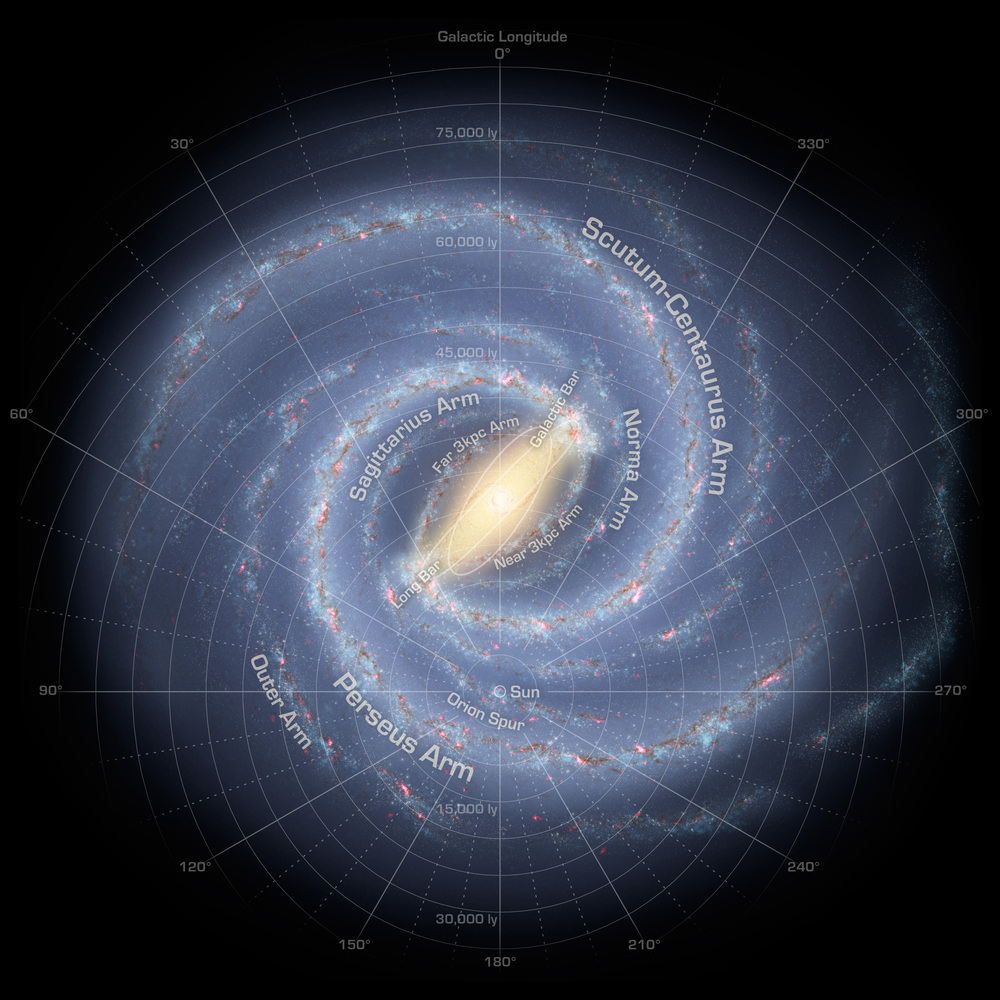Fact Impact - The Milky Way
25 February 2011
Interview with
Carolin Crawford, Cambridge University
- All the stars you can see at night with the unaided eye lie in our home, the Milky Way
- In total, the Galaxy contains around 400 billion stars
- Many of them suns like our own, surrounded by their own planetary systems.
-
 The Milky Way is shaped like two fried eggs back-to-back
The Milky Way is shaped like two fried eggs back-to-back - A large central bulge is surrounded by a flat disc of stars measuring some 120,000 light-years across
- But only a few thousand light-years thick.
- The central bulge of stars is about 12,000 light years in diameter
- It consists of a much older population of stars than found in the disk
- ...and is substantially elongated, making The Milky Way a barred spiral galaxy
- The disc contains the spiral arms, which appear prominent as they contain hot, luminous stars
- They are sites of active star formation, and are lined with glowing gas nebulae and young blue star clusters
- Where stars have formed in groups, all originally having collapsed from the same dense molecular cloud.
- The Galaxy has four spiral arms; known as the Perseus, Scutum-Crux, Carina & Sagittarius, and Norma & Cygnus arms
- The Sun lies halfway out from the centre to the edge of the stellar disc
- And is located in the Orion arm, a small outer spur of the Cygnus arm
- All the stars in the disc - including the Sun - are rotating in near-circular orbits
- The Sun is orbiting at a speed of around 220 km/s, moving in the direction of the star known as Vega
- Even at that speed, it takes us around 250 million years to travel once round the centre of the galaxy.
- Detailed study of the speeds of stars in the rotating disc reveals that the mass of the Galaxy is around eight hundred thousand million times the mass of the Sun
- But over 90% of this mass is in the form of an invisible giant halo of dark matter, which only reveals itself by its gravitational pull on the visible matter
- Its mass is so great that it is gravity of the dark matter (rather than of all the stars) that holds the galaxy together.

- The centre of the Milky Way lies in the direction of the constellation of Sagittarius, and is some 30,000 light-years away from us
- It is marked by intense radio feature, called Sagittarius A*, which is surrounded by a cluster of hot young stars
- Many of these stars are moving very fast in tight orbits around a mass some 4 million times that of the Sun
- Which must be contained within a volume less than the size of our Solar System
- This is the evidence that the core of our Galaxy hosts a super-massive black hole
- Which remains dormant, not actively accreting any matter.
- The Milky Way is not alone in space
- Along with its sister galaxy Andromeda and the Triangulum Galaxy, it is part of the 'Local Group', a collection of around 25-30 galaxies spread over a region some 10 million light-years across
- Which in turn is at the outskirts of the Virgo supercluster of galaxies, some 150 million light-years in diameter.
- Two of the small galaxies in orbit around the Milky Way can be seen in the Southern hemisphere night sky
- Known as the Magellanic clouds, they lie 160,000 and 200,000 light years away
- ...and are slowly being distorted and pulled apart by the tidal forces from the Milky Way's gravity.
- A new satellite galaxy was only discovered in 1994, and it is known as the Sagittarius Dwarf Elliptical Galaxy (SagDEG)
- It moves in a polar orbit very close to the Milky Way, but is currently on the opposite side of the Galactic Center from the Solar System
- ...and is also being shredded by the Galaxy's gravitational pull, shedding a long stream of stars in its wake.
- The close proximity of such satellite galaxies as the Magellanic clouds and SagDEG have in return affected the Milky Way
- Their tidal gravitational forces have slightly warped the disc of the MW so it is not completely flat.
- The Milky Way is on a collision course with its near neighbour, the Andromeda galaxy
- They are heading towards each other at a rate of about 500,000 kmph
- ...and the two galaxies are expected to begin the process of merging within a few billion years.










Comments
Add a comment